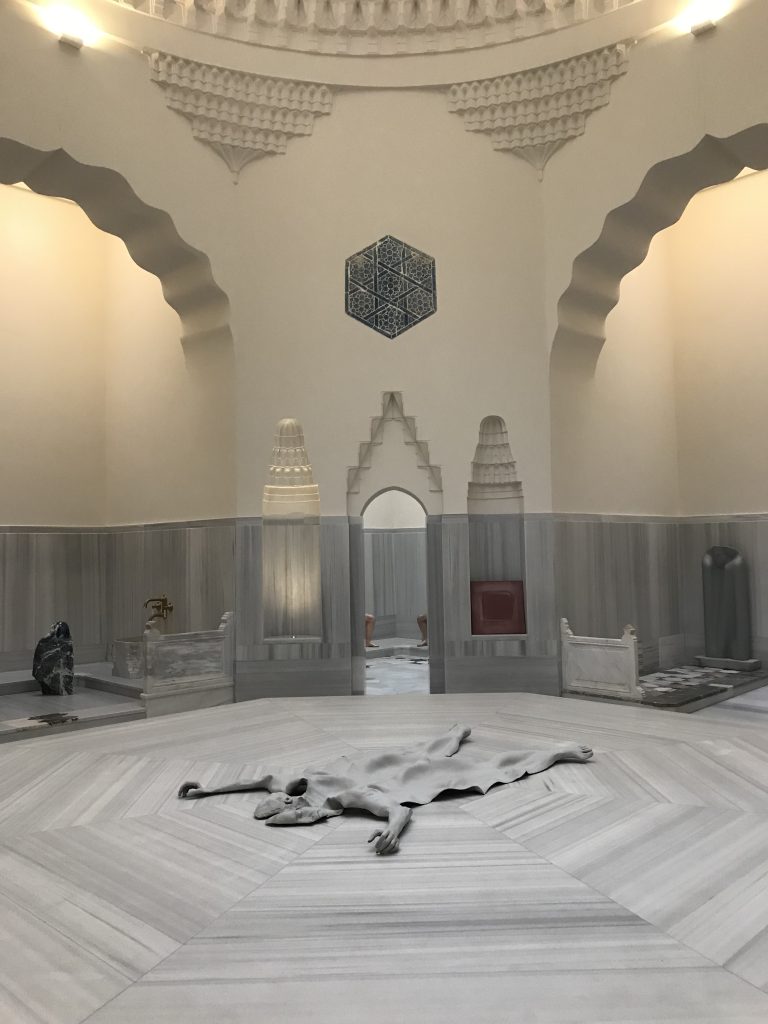I am stretched out on the marble slab in the centre of the Çemberlitaş Hamam, soaking up the steamy atmosphere of one of İstanbul’s many Turkish baths. Dust-dappled sunlight streams down on me through starlights cut out of the dome while the velvety voice of a masseuse rises in song, the splendid acoustics of the building lifting and magnifying the sound as in a medieval cathedral. Then another masseuse starts to beat out a rhythm on an upturned bowl and a third jumps onto the slab, slings a scarf around her hips and begins to dance, thrusting her pelvis and wriggling her belly as only a Turkish woman knows how. At once I am cast back in time to the days when a visit to the baths played a central role in the lives of many local women.
Of all the many delights on offer in Turkey a trip to the hamam has to be one of the most enjoyable. After a hard day’s sightseeing there is nothing better than lying down in the warm embrace of a bathhouse and letting someone else scrub off the sweat and massage away the aches and pains of the day. You’re guaranteed to walk away feeling squeaky-clean and utterly relaxed. All this for a fraction of the price you pay for similar pampering at home.
The hamam tradition dates back to Roman times when a visit to the public baths was part of everyday life all around the Mediterranean. However, while the habit quickly died out in Western Europe it hung on further east and was taken up in turn by the Selçuk and Ottoman conquerors of the land that became modern Turkey. Even today some Turks still think life would not be worth living without their regular trip to the hamam. But, sadly, now that private homes generally have decent bathrooms most women have kissed goodbye to a ritual that used to so enrich their lives.
In the 19th century women routinely spent whole days luxuriating in the baths, bringing along picnics and taking the opportunity to size up potential wives for their sons. Brides would go to the baths before their big day, as would new mothers fresh from their lying-in. Even today some women – and many men – still head for the nearest hamam to ensure perfect cleanliness before Fridays and Islamic holidays.
First-time visitors are sometimes anxious about venturing into a hamam, but there is really nothing to worry about. Once inside, you undress in the lobby and wrap yourself in a peştemal, a thin towel that resembles a giant tea-cloth. Then you enter the main part of the hamam, which usually features a spectacular dome soaring above a solid slab of marble (göbektaşı – navel stone). The room’s lower walls will be faced with marble and lined with basins. You sit beside one of them and run the water until it’s just the right temperature before scooping it out of the basin with a bowl and pouring it over yourself.
Then comes the best bit. You lie down on the marble slab and let your skin soften in the steam until a bath attendant comes to scrub you with a kese, a special mitten with the texture of a cat’s tongue that will remove layers of dirt and dead skin you would never have believed were there. The wash is rounded off with a good soaping before the final luxury of an invigorating massage. Then you relax on the slab until you can summon up the energy to stumble back into the changing room.
All this is pleasure enough but the greatest enjoyment comes from a massage in one of the many beautiful old hamams that still litter İstanbul. The stunning Çemberlitaş Hamam is one of the most famous because it was designed in 1584 by Mimar Sinan, the greatest of all the Ottoman architects. It’s ideal for your first visit to a hamam. Alternatively, you can visit Cağaloğlu Hamam, a gorgeous building dating back to 1741 where Florence Nightingale and Kaiser Wilhelm II famously submitted their bodies to a soapy pummelling. The Galatasaray Hamam (1715), just off the pedestrianised shopping street İstiklal Caddesi, is a great place for male bathers, if less so for women.
These three hamams have been welcoming tourists for decades but recently the old baths attached to the great Süleymaniye mosque also reopened to the public. Another work of Sinan dating back to 1557, this hamam is architecturally magnificent but offers only mixed bathing, an arrangement unimaginable in traditional Turkish society where men and women bathed on different days, at different times or in separate areas of a double hamam.
In a city of more than 12 million people there are hamams aplenty and while some are mundane modern buildings others are are well worth the extra effort involved in tracking them down. You could, for example, venture into the Ağa Hamam in Çukurcuma, a district best known for its antique shops. The Ağa is a neighbourhood hamam, still visited by locals and housed in a deceptively modern building that hides the fact that the bath inside dates back to 1562. Or you could cross the Bosphorus to Üsküdar and try out the glorious Çinili (Tiled) Hamam, which dates back to 1648. It’s at the top of a steep hill which should make the massage all the more enjoyable when you reach it.
Written in 2007


